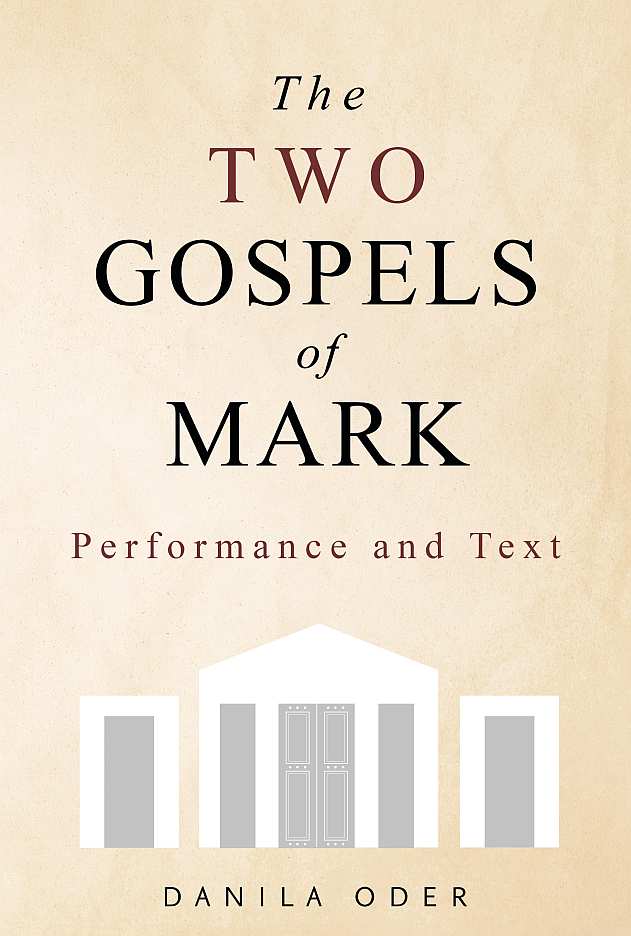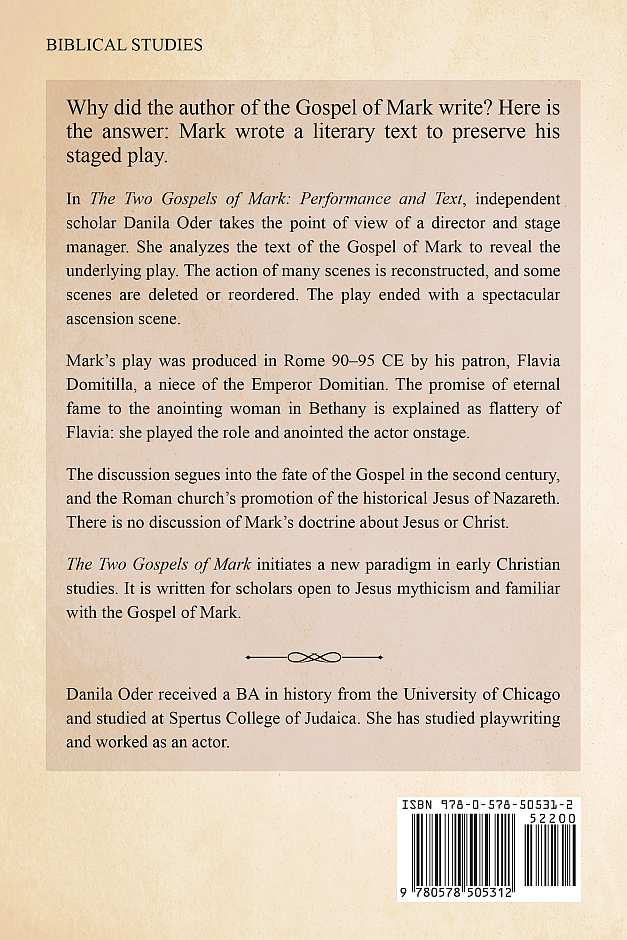As of June 22, 2023, this blog is no longer updated. It will remain online for a while; it is also available at the Internet Archive Wayback Machine. Thank you for your interest.
A revolutionary new proposal for the origin of the Gospel of Mark assumes Jesus mythicism. In The Two Gospels of Mark: Performance and Text, historian Danila Oder proposes that “Mark” was a playwright in Rome in 90–95 CE. He wrote a play in which his Judean congregation’s heavenly Jesus comes to earth. Jesus is on a mission to fulfill Scripture by suffering and dying, then returning to the heavens. The play was based on scenarios from Scripture, mythology, and Homer. It was performed on a stage before an audience of Mark’s congregants. The play was an entertainment in the genre of mime. The performance was not a religious event.
Oder approaches the Gospel of Mark from a theater director’s practical point of view. She identifies the stage directions in the received text and tests them out in a miniature theater. She identifies the plot and subplot of the play. She even provides an outline of the action of the original performed play.
The book’s title refers to “two gospels of Mark” because Mark preserved the (single) performance of the play. He revised the script into a narrative text with an invisible narrator. Mark condensed the dialogue, and added literary features like chiasms and names of actors and locations not spoken in the play. Mark made references to his sources in Scripture to serve readers/listeners. He hoped the text would take its place in his sect’s Scripture. That narrative text was the original form of the Gospel of Mark we know.
Oder speculates that the play was produced by the historical Flavia Domitilla, niece of the emperor Domitian and mother of future emperors. She and her husband, Titus Flavius Clemens, were honored during the performance. Flavia may have been introduced to the congregation by her mentor, Princess Berenice (discussed on this blog). Oder’s theory therefore can be seen as a Roman Provenance Theory or Flavian Provenance Theory.
The congregation kept the narrative in its library, as evidence of Flavia’s patronage, but did not circulate it or use it in worship. Mark’s play was entertainment sponsored by an elite Gentile; we cannot assume that the doctrine expressed in the play was the mainstream doctrine of the congregation.
Oder situates Mark in a real place and time, with a real purpose for writing the Gospel of Mark. Oder identifies editing throughout the text, and provides a tentative reconstruction of the action of the staged play.
Danila Oder’s insights into the Gospel of Mark and her inductive reconstruction of its Roman provenance have many implications for the history of early Christianity. The Two Gospels of Mark: Performance and Text is also of interest to scholars of ancient theater, particularly Roman mime, and to historians of the Flavian period.
This theory is summarized in the anthology Varieties of Jesus Mythicism: Did He Even Exist? My review here.
In the blog on this website, Oder moves outward from the book, revisiting and expanding on her portrait of the performance of Mark’s play, the life of Flavia Domitilla and her family, Mark’s narrative text and its editing, Mark’s congregation in Rome, and the history of orthodoxy in the second century.
Reviews of The Two Gospels of Mark: Performance and Text
“Tightly argued….A fascinating exploration of possibilities behind our gospel text….A seriously fresh approach to the Gospel” – Neil Godfrey, Review on Vridar, March 4, 2020.
“The most elaborate and well-argued version” of the theory that the Gospel of Mark was originally dramatic – Robert M. Price, “The Source for Mark’s Gospel must have been a mystery play?” Mythvision Podcast, August 11, 2020.
“What she knows and brings to bear on it, it is really thought-provoking” – Robert M. Price, “The Gospels are a Greek Theatre Production,” Mythvision Podcast, December 15, 2020.
Reviews of Oder’s chapter in Varieties of Jesus Mythicism: Did He Even Exist?
“Although I am not persuaded, her overall theory is competently argued and provides a model for how to employ evidence and argumentation…. Overall, I must say that her chapter is easy (and rewarding) to read because its gaps in logic and evidence are not concealed, nothing is fabricated, lied about, or misrepresented, and its speculations are mostly plausible.” – Richard Carrier, (book) Review in Socio-Historical Examination of Religion and Ministry, Volume 4, Issue 1, Summer 2022.
Expanded review on Richard Carrier’s website, October 8, 2022.



rev. May 13, 2022; Carrier review added September 20, 2022.